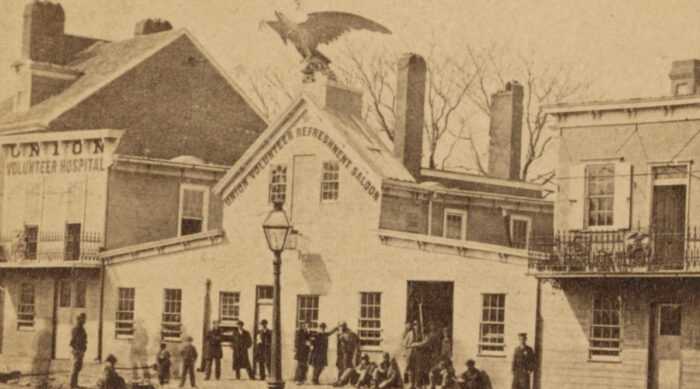
I have written many times about the taverns and bars that were so important to Capitol Hill in its earliest years, and I am constantly drawn back to this subject. Today, we will look at a bar named Our House, which was in the middle of (8th) Street.
Pre-Civil War records are spotty, at best, so the exact day that John A. Golden opened his bar on 8th between I and K Streets Southeast cannot be determined. However, it must have been around 1840, when the Irish-born Golden was about thirty years of age. He first appears in the city directories of the city in 1846, which notes only that he had a tavern.
Somewhere along the line, Golden married Margaret Crane, who had at least four children from a previous marriage, and, in 1850, the household consisted John and Margaret, two of her children, plus three other Irish-born tweens.
Three years later, the city directory is a little more informative, although some of that information is wrong: It states that Golden’s bar is located on the North side of 8th street East, which is, of course, impossible. The previous directory placed him properly on the east side of that street. What is interesting is that the tavern is now given a name: Our House.

The tavern and its proprietor made the news in 1854 when he was shot in the chest at his place of business. The Washington Sentinel reported two days later:
On Thursday, a man, named Monroe, went into a tavern, at the navy yard, and after taking a glass of brandy and sugar, seing the proprietor of the establishment, John A. Goldin, [sic] coming in at the front door, deliberately drew a pistol and shot him in the breast. Although the assailant was not more than two feet from his victim, eight of the shot entered only skin-deep, according to the statement of our informant. Justice Crandall sent Monroe to jail to await trial. The offender was a few weeks since discharged as a marine, from the barracks. As no previous misunderstanding existed between Monroe and Goldin, the supposition is that the man is insane.
During the trial a few days later, it came out that Golden had “published” Monroe a year previously, though but he “refused to tell the nature of the article.” At this point, the newspapers of the time seem to have lost interest, especially as Monroe’s injuries were said to be slight.
How true this was cannot be said at this late date, but less than a year later, Golden was selling “the good will, License, Furniture, Fixtures &c., of a well known and long established Tavern.”
In his retirement, Golden turned to politics, joining the Sixth Ward Sag Nichts Association. The Sag Nichts were mainly German and Irish immigrants drawn together over their mutual suspicion of the Know Nothings who were infecting the body politic at the time. The name Sag Nichts is German for “Say Nothing.”
The Sag Nichts are today relegated to a footnote in history, so it is unlikely that Golden had much of an influence there – especially as he died shortly after joining the association. In 1858, Margaret is listed as a widow, living on 8th Street East.
More on her and her children in future episodes.
